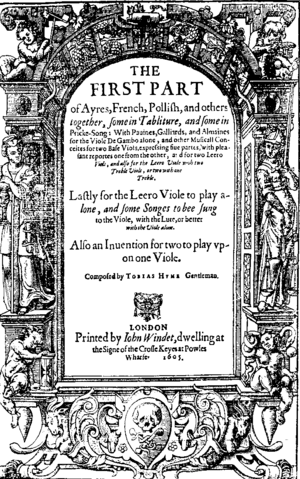John Windet facts for kids

John Windet was an important English printer who lived from about 1584 to 1611. He was especially known for printing music. Windet worked closely with another printer named John Wolfe.
After 1591, John Windet took over printing a very popular book of songs called the metrical psalter. This book was originally printed by Wolfe. Windet became the only printer of this book for Richard Day, who had the special permission, or patent, to print it. Later, Windet also became the official printer for the City of London, known as the City Printer. When John Wolfe stopped printing in 1594, he gave some of his special printing designs to Windet. After Wolfe passed away in 1601, Windet was put in charge of managing his business.
Windet's Music Printing
John Windet printed many important music books. In 1604, he printed a famous work by John Dowland called Lachrimae, or Seaven Teares. This book was a collection of slow dances called pavans and was a very important musical work of that time.
Printing for Tobias Hume
Windet also printed all the known music by the composer Tobias Hume. These were in two collections: First Part of Ayres (1605) and Captaine Humes Poeticall Musicke (1607). Hume was a very unusual composer, and Windet likely needed all his printing skills to handle his unique ideas.
The First Part of Ayres included special instructions for playing music. It had what might be the first examples of:
- Pizzicato: This means "to be played with your fingers" (instead of a bow).
- Col legno: This means "Drum this with the back of your Bow."
These playing styles were quite strange for the time. One piece in the First Part of Ayres even had instructions for "two to play upon one Viole," where one musician had to sit on the other's lap! Windet also printed music for other composers like Robert Jones, John Coprario, and Thomas Ford.
Working with William Stansby
On December 25, 1590, John Windet took on William Stansby as his apprentice. An apprentice is someone who learns a trade from a skilled master. Six years later, Windet gave Stansby his "freedom," meaning Stansby had completed his training. On January 7, 1597, Stansby became a full member of the Stationers' Company, which was a group for printers and booksellers.
Stansby probably didn't have enough money to start his own business right away. So, he stayed and worked with Windet at his shop called "the Crosse Keys at Powles Wharfe." Windet even helped Stansby print his very first book, The Policy of the Turkish Empire, in April 1597.
John Windet continued printing until he passed away in either 1610 or 1611. After his death, William Stansby took over the Cross Keys shop. On September 11, 1611, Stansby also inherited 47 of Windet's copyrights, which gave him the right to print those specific books.

